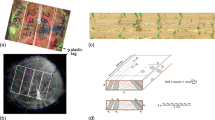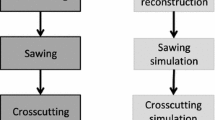Abstract
Detailed three dimensional models are nowadays frequently used in cross-cutting (bucking) tree stems into logs and in breakdown processes of logs into boards and flitches. Such models require increasingly sophisticated optimization models to assist planners (or automated decision support systems) in decision making. In this paper we develop two techniques that are linked to each other. The first is concerned with establishing high quality analytic approximations of full trees that are needed in full stem bucking applications. One important aspect is that inaccuracies due to measurement error can be reduced. The second is a transformation technique that makes it possible to apply curve sawing on logs in a standard straight sawing system. Numerical results based on real data are presented that support the usefulness of the techniques.
Similar content being viewed by others
References
T. Allsopp, Analytic description of tree stem geometry, Final Year Project, Department of Engineering Science, The University of Auckland, Auckland, New Zealand (1996).
I. Anttila, Why curve sawing? Is there a benefit for you?, in: Proceedings of SawTech'93, San Francisco, CA (October 14-16, 1993).
D. Briggs, A dynamic programming approach to optimizing stem conversion, Ph.D. thesis, University of Washington, Seattle, WA (1980).
A.G. Brown and R.G. Miller, Effect of sweep on sawn recovery from radiata pine logs, Australian Forest Research 7(1) (1975) 29–39.
R.L. Burden, J.D. Faires and A.C. Reynolds, Numerical Analysis, 2nd edn (Prindle, Weber and Schmidt, 1981).
Consolidated Sawmill Manufacturing International, Throwing mills a curve: A renaissance technology, Canadian Wood Products (March/April 1994) 10–11.
D.J. Cown, D.L. McConchie and C. Treloar, Timber recovery from pruned pinus radiata butt logs at mangatu: Effect of log sweep, NZ Journal of Forestry Science 141) (1984) 109–123.
P. Dierckx, Curve and Surface Fitting with Splines (Oxford University Press, New York, 1993).
J. Dobie, Log sweep and lumber production in the B.C. Interior, British Columbia Lumberman 48(10) (1964) 34–37.
J. Dobie and G.R. Middleton, Lumber yields from sweepy lodgepole pine, The Forestry Chronicle 56(2) (1980) 66–67.
B. Faaland and D. Briggs, Log bucking and lumber manufacturing using dynamic programming, Management Science 30 (1984) 245–257.
J.W. Funck and Y. Zeng, Integrating an expert system and dynamic programming approach to optimize log breakdown while considering lumber grade, in: Proceedings of the 49th Annual Meeting of The Forest Products Society, Portland, OR (June 28, 1995).
J.W. Funck, Y. Zeng, C.C. Brunner and D.A. Butler, SAW3D: A real shape log breakdown model, in: Proceedings of the 5th International Conference on Scanning Technology and Process Control for the Wood Products Industry, Atlanta, GA, USA (October 25-27, 1993)
J. Geerts, Mathematical solution for optimising the sawing pattern of a log given its dimensions and its defect core, New Zealand Journal of Forestry Science 14(1) (1984) 124–134.
P.C. Gilmore and R.E. Gomory, Multistage cutting stock problem of two and more dimensions, Operations Research 13 (1965) 94–120.
P.C. Gilmore and R.E. Gomory, The theory and computation of knapsack problems, Operations Research 14 (1966) 1045–1074.
D.W. Lewis, Sawmill simulation and the best opening face system: A user's guide, USDA Forest Service, Gen. Tech. Rep. FPL 48, Madison, WI (1985).
W. McInvale, Curve sawing technology and benefits, Timber Processing (September, 1993) 14–19, 31.
NAG, The NAG Fortran Library Manual - Mark 13, The Numerical Algorithms Group (Oxford, 1988).
Netlib, Internet http://www.netlib.org.
L.G. Occeña and J.M.A. Tanchoco, Computer graphics simulation of hardwood log sawing, Forest Products Journal 38(10) (1988) 72–76.
R. Parker, R. Park, B. Clement and W. Gibbons, Effect of number of log grades on log making errors, Logging Industry Research Organisation N.Z. Report, Vol. 20, No. 23 (1995).
M.P. Reinders and H. Hendriks, Lumber production optimization, European Journal of Operational Research 42 (1989) 243–253.
S. Tejavibulya, Dynamic programming sawing models for optimizing lumber recovery, Ph.D. dissertation, College of Forest Resources, University of Washington, Seattle, WA (1981) 62 p.
C.L. Todoroki, AUTOSAW system for sawing simulation NZ, Journal of Forestry Science 20(3) (1990) 332–348.
C. Todoroki, Developments of the sawing simulation software, AUTOSAW: linking wood properties, sawing, and lumber end-use, in: Proceedings of the Second Workshop, IUFRO S5.01-04, INRA, ed. G. Nepveu, Nancy, France (1997) pp. 241–247.
C. Todoroki and M. R¨onnqvist, Secondary breakdown optimization with dynamic programming, Journal of Operational Research Society 48 (1997) 471–478.
S.J. Wang, B.D. Munro, D.R. Giles and D.M. Wright, Curve sawing performanc evaluation, Forest Products Journal 42(1) (1992) 15–20.
Author information
Authors and Affiliations
Rights and permissions
About this article
Cite this article
Rönnqvist, M., Todoroki, C. & Allsopp, T. Usage of 3D geometry descriptions and transformation techniques in log bucking and curve sawing. Annals of Operations Research 95, 93–113 (2000). https://doi.org/10.1023/A:1018962410199
Issue Date:
DOI: https://doi.org/10.1023/A:1018962410199




